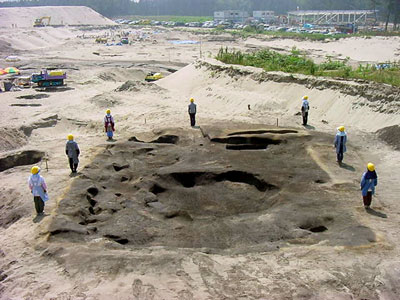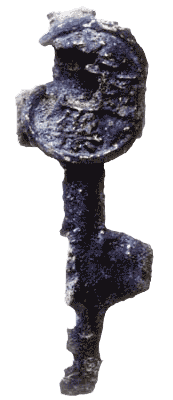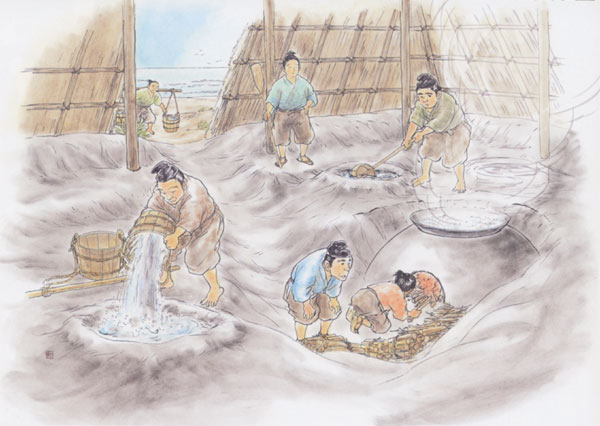Muramatsu Shirane:
A salt-producing village buried in the sand is discovered. An Edo period legend becomes clear.

Remains of buildings discovered in line (from the west)
Atop a sand dune 70 m east-west by 60 m north-south, remains were discovered of a village built by packing down humus-rich black earth (chernozem). The remains of several buildings lined up with their long axes oriented to the northeast can be seen in the photo.

Salt making hut and brine vats |

Brine vat |

|
| |
|
Unfinished coinage | ||
Muramatsu Shirane Site, Tōkai Village, Ibaraki Prefecture
Muramatsu Shirane is a salt-making site located along the seashore in Tōkai Village, in the eastern portion of Ibaraki Prefecture. Formerly there was an inlet named Masakiura in this vicinity, where many ships came and went. In the Muromachi period this was part of the domain of the Satake clan, to which the salt was supplied. In the “Matsumura shiogama Masaki iran” [Muramatsu salt works Masaki disturbance] (contained in the Ryōchi iransho fusha, a document in the collection of the Okamoto Motoasa household), a controversy surrounding a salt works is recorded, and from the vicinity where these salt-making facilities were supposedly located, remains were discovered of a village and salt-making huts (where salt crystals were extracted by boiling sea brine in earth ovens) from the second half of the fifteenth to the first half of the seventeenth centuries.
Salt-making remains discovered from atop a sand dune
At a level five meters below the modern sand dune, salt-making facilities comprised of a salt-making hut and several brine vats were discovered at twenty-one locations. A total of 195 brine vats were found. In addition, along with structures where the people engaged in salt making lived, there were features comprised of ridges (of farm plots), a locus for gathering shellfish, wells, burials, etc. Between the humus-rich black earth (chernozem) layers forming the basis of these features were multiple strata of sand deposits, showing that salt making was conducted over a number of periods. The site has received attention as confirmation of the record mentioned above of the disturbance at the Muramatsu salt works, and of a local legend from the early Edo period, “Chiji ranpū” [Myriad wild winds], telling of a village buried under sand borne by a great wind.
Villagers who valued recreation and ritual
The rich variety of artifacts recovered from the site begin with a ceramic inventory of local terra cotta ware, plus Seto, Mino and Bizen varieties of stoneware as well as Chinese porcelain; items of daily living such as stone basins, ink grinding stones, kōgai hair ornaments, strike-a-lights, and tweezers; plus more than 2,000 pieces of old coins and unfinished coinage in the process of casting. In addition, from the recovery of dice and clay masks, it is possible to catch glimpses of the livelihoods of people, who in the midst of the heavy labor of salt making, still valued recreation and ritual life. (Minagawa Osamu)

